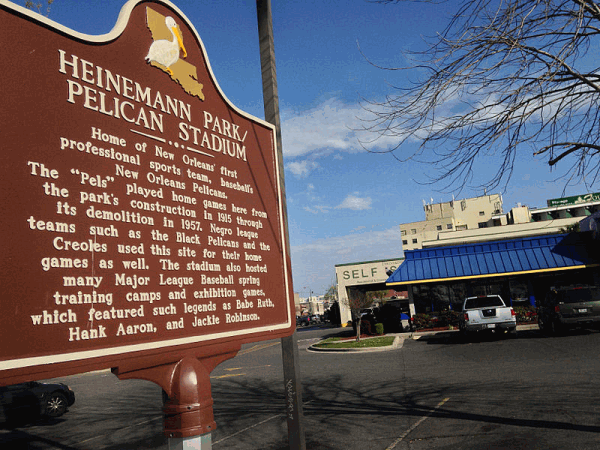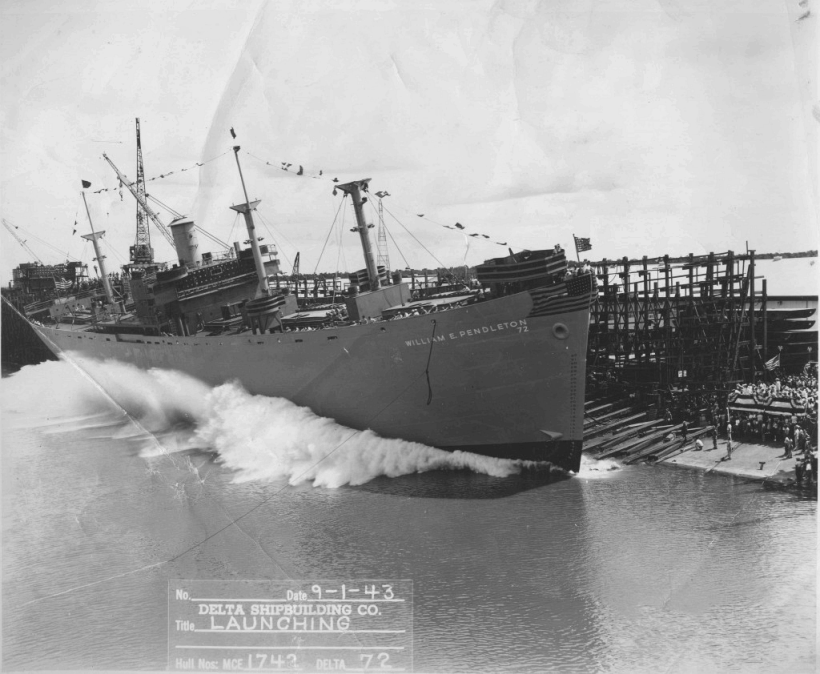|
Today in New Orleans History |
|
|
September 1


 To receive an update for each day in New Orleans history,
join our facebook page - Today in New
Orleans History.
Pelican Stadium Closes Historical plaque at Carrollton and Tulane Avenue Story by Buddy Stall The last baseball game to be played at the old New
Orleans Pelican Stadium occurred on Sunday, Sept. 1, 1957. The Pelicans had furnished fond memories at this location dating
back to April 13, 1915, when the site was officially opened after having been moved piecemeal from Banks and Carrollton by
mules and then reconstructed at the Tulane and Carrollton location.  To receive an update for each day in New Orleans
history, join our facebook page
- Today in New Orleans History
Born in New Orleans on Septermber 1, 1900, jazz drummer Alfred Williams performed
with the Tuxedo Orchestra during the 1910s and with Sam Morgan, Manuel Perez and A.J. Piron on the riverboats beginning in
the 1920s. In 1936 Williams left New Orleans but returned in 1951 and played frequently with the Preservation
Hall Band until his death on April 30, 1963 in New Orleans.
The New Orleans Bee (French: L’Abeille de la Nouvelle-Orléans, Spanish:
La Abeja de Nueva Orleans) was a newspaper in New Orleans, Louisiana, founded on September 1, 1827,
by François Delaup and originally located at 94 St. Peter, between Royal and Bourbon. Initially published three times
a week in French, an English section was added on November 24, 1827, and in this form it was the most successful of New Orleans
daily newspapers in the middle of the nineteenth century. The English section was abandoned in 1872 because of increased competition
from English-language newspapers, but later restored. A Spanish-language section (Abeja) was published in 1829-1830. Until
at least 1897 L'Abeille remained "almost certainly the daily newspaper of choice" for French officials in New Orleans.
The title was purchased in 1921 by The Times-Picayune and was published weekly until it closed in 1923. It was by some accounts
the last French-language newspaper in New Orleans, ceasing publication on December 27, 1923, after ninety-six years; others
assert that it was outlasted by Le Courrier de la Nouvelle Orleans, which continued until 1955. President Bush appeared on Good Morning
America, and said that he understood the frustration of Katrina victims, many of whom are still waiting for food, water,
and other aid. "I fully understand people wanting things to have happened yesterday," Bush said. "I understand
the anxiety of people on the ground. … So there is frustration. But I want people to know there's a lot of help coming."
He said that the government's first priority is to save lives, and described the devastation that he saw while flying over
the hardest-hit areas as, "very emotional," but was also very optimistic about the prospects of New Orleans' recovery. A 50-member Canadian search-and-rescue team from Vancouver, British Columbia reached a flooded
New Orleans suburb to help save trapped residents. National Guardsmen accompanied by buses (475 in all) and supply
trucks begin to arrive at the Superdome. A day after the National Guard (from Camp Beauregard) began delivering food, water and
ice in New Orleans, the National President of the American Red Cross, Marsha Evans, requested to set up a shelter in New
Orleans to pass out food and water. However, due to the ongoing military rescue operations in the city at the time, the
Red Cross was asked to wait for 24 hours. By Saturday, the point was moot because the large-scale evacuation of the city
was already underway. Meanwhile, conditions at
the Superdome, as well as the Ernest N. Morial Convention Center, continued to deteriorate. Food and potable water were
unavailable, with mostly false reports and rumors of rescuers coming under fire from people seeking to hijack supplies or
transportation, and few buses were arriving to evacuate the survivors. About 5,000 refugees made it by bus to Reliant Astrodome,
yet there were only about 2,000 cots available. Secretary Chertoff is criticized by NPR's Robert Siegel during an interview on All Things Considered, as he had no knowledge of the approximately
2,000 survivors at the Convention Center with no food or water. He said, "I have not heard a report of thousands of
people in the Convention Center who don't have food and water."[37] FEMA Director Brown said that FEMA only became aware of crisis at the Convention Center on
this date, yet later claims to have known about it 24 hours earlier. Secretary Chertoff
announced that 4,200 National Guard troops trained as military police would be deployed to New Orleans over the next three
days. Governor Blanco requested the mobilization of an additional 40,000 National Guard troops. 14,284 Army National Guard
and 972 Air National Guard were currently deployed (15,256 total). California swift water rescue crew units deployed to
the area rescued hundreds in New Orleans and Jefferson Parish. However, FEMA later halted the swift water rescue crews from
conducting further rescues, citing safety concerns. Sealing of the
17th Street Canal from Lake Pontchartrain with sheet pilings begins, while closing the breach continues. The New Orleans suburb of
Gretna seals the Crescent City Connection bridge across the Mississippi River, turning back fleeing flood victims at gunpoint.
Evacuees blamed the incident on racism, but the chief of police stated that the city was in lockdown and was not equipped
to handle evacuees from New Orleans. The Kansas City
Southern Railway reopened its Meridian Speedway railway line between Meridian, Mississippi, and Shreveport, Louisiana, after
clearing debris and repairing damage caused by Hurricane Katrina. The line is also used by Norfolk
Southern as a bridge route for NS intermodal trains between the Meridian and Alliance,
Texas. KCS is also working with CSX Transportation and Meridian and Bigbee Railway to transfer additional intermodal traffic through Meridian rather than New
Orleans or Birmingham. President Bush
signed a $10.5 billion relief
package that was passed by Congress which included
supplemental funds for FEMA, as well as $500 million
for the Pentagon for its relief efforts. He also toured the hurricane-battered Gulf Coast, saying that he is ordering additional active duty forces
to the region, and authorized a withdrawal of oil from the Strategic Petroleum Reserve. The Bush administration sent Governor Blanco a proposed legal memorandum asking her
to request a federal takeover of the evacuation of New Orleans. Louisiana officials eventually rejected the request after
talks throughout the night, concerned that such a move would be comparable to a federal declaration of martial law. Sheet piling blocks water flow into the 17th Street Canal, making
closure of the breach not relevant to city flooding. Work on closing the breach continues for purposes of pumping. In a letter to
the governors of Louisiana, Mississippi and Alabama, BNSF Railway (headquartered in Fort Worth, Texas) pledged a contribution
of $1 Million, and offered rail transportation to aid in relief efforts for the areas affected by Hurricane Katrina.
The monetary contribution came from the Burlington Northern Santa Fe Foundation as a donation to the American Red Cross relief
efforts, while the transportation assistance was organized by the Association of American Railroads, the Federal Emergency
Management Agency, the Federal Railroad Administration, as well as other railroads that serve the area. The letter also stated
that repairs to the Bayou Boeuf bridge were now completed and BNSF's mainline was reopened as originally planned at 6:00
PM CST on September 1.
|
|
|

To receive an update for each day in New Orleans history,
join our facebook page - Today in New
Orleans History.
Analytics |



